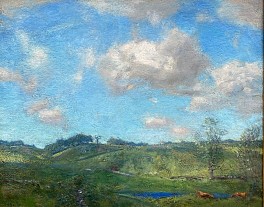BIOGRAPHY

CHARLES HAROLD DAVIS
(1856-1933)
Charles Harold Davis was born in Amesbury, Massachusetts. He showed interest in art at an early age and was inspired to pursue artistic training after attending an exhibit of French Barbizon painting in Boston. Shortly thereafter, Davis enrolled in the Museum School at the Museum of Fine Arts in Boston where he studied under Otto Grundmann (1844-1890). In 1881, Davis went to Paris for further study and remained there for nearly a decade.
During those years in France, he studied at the Academie Julian and painted landscapes of the French countryside, in particular Fontainebleau and Normandy. These French paintings have been referred to by foremost American art historian William Gerdts as "softly Tonal landscapes in the Barbizon mode that are among the finest painted by any American.” Davis exhibited at the Paris Salon and at the Paris Exposition, receiving recognition at both venues. Meanwhile, he enhanced his reputation in the United States by sending works home for exhibition in New York and Boston.
Davis returned from France in 1890 and, after carefully considering proximity to the ocean with a varied topography he decided to settle in in Mystic, Connecticut, where he resided for the rest of his career. In Mystic, Davis’s palate started to incorporated lighter colors and his brushwork became more gestural shifting from tonal Barbizon to a more Impressionist style. Around 1895, Davis’s thematic focus became the sky, specifically cloudscapes for which he would eventually become very well-known. In these richly colored, sun-filled paintings of the Connecticut countryside, Davis depicts low horizons and big skies filled with dancing clouds casting shadows across the landscape.
A leading figure of the newly forming Mystic Art Colony, Davis also founded the Mystic Art Association in 1913. Other artist’s who followed Davis’s to Mystic included David Walkley and John Joseph Enneking. A successful painter who received much critical acclaim during his lifetime, Davis had one-man shows at William Macbeth’s gallery in New York and at Doll and Richards in Boston, and his works were exhibited around the country in major national and international exhibitions of the period.
CHARLES HAROLD DAVIS
(American, 1856-1933)
Memberships
Society of American Artists, New York, NY
National Academy of Design, New York, NY
Copley Society, Boston, MA
Lotos Club, New York, NY
National Arts Club, New York, NY
Society of Mystic Artists, Mystic, CT
Awards
Honorable Mention (Paris Salon, 1887)
Silver Medal (Exposition Universelle, Paris, 1889)
Palmer Prize (Art Institute of Chicago, 1890)
Medal (Massachusetts Charitable Mechanic’s Association, Boston, 1890)
Medal (Columbian Exposition, Chicago, 1893)
Grand Gold Medal (American Art Association, New York, 1896)
Cash Prize (American Art Association, 1897)
Potter Palmer Prize (Chicago Art Institute, 1898)
Bronze Medal (Exposition Universelle, Paris, 1900)
Lippincott Prize (Pennsylvania Academy of Fine Arts, Philadelphia, 1901)
Silver Medal (Pan-American Exposition, Buffalo, 1901)
Silver Medal (Universal Exposition, St. Louis, 1904)
Silver Medal (Universal Exposition International, 1910)
Gold Medal (Panama-Pacific Exposition, San Francisco, 1915)
Second W.A. Clark Prize and Corcoran Silver Medal (Corcoran Gallery, Washington, 1920)
Saltus Medal (National Academy of Design, 1921)
Select Public Collections
Pennsylvania Academy of Fine Arts, Philadelphia, PA
Corcoran Gallery of Art, Washington, D.C.
National Museum of American Art, Washington, D.C.
Metropolitan Museum of Art, New York, NY
Art Institute of Chicago, Chicago, IL
Wadsworth Atheneum, Hartford, CT
Boston Museum of Fine Arts, Boston, MA
Carnegie Institute, Pittsburgh, PA
Butler Art Institute, Youngstown, OH
Bruce Museum, Greenwich, CT
New Britain Museum of American Art, New Britain, CT
Los Angeles County Museum of Art, Los Angeles, CA
